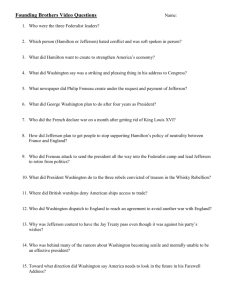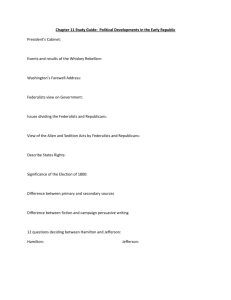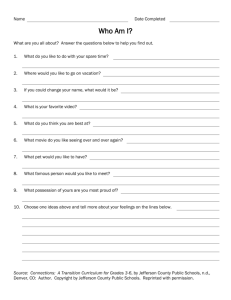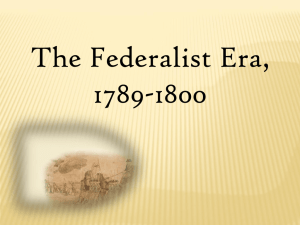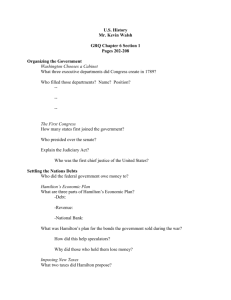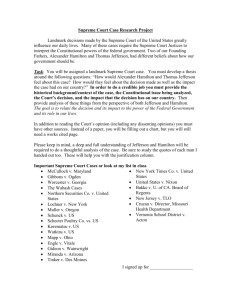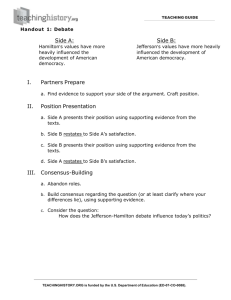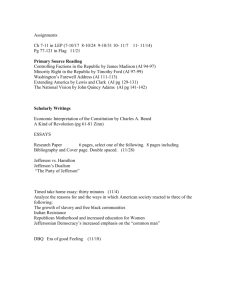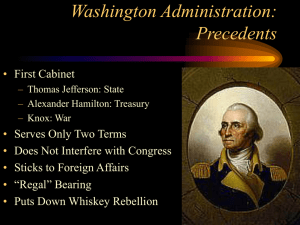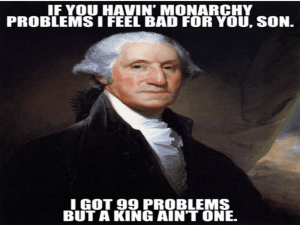Alexander Hamilton And Thomas Jefferson
advertisement
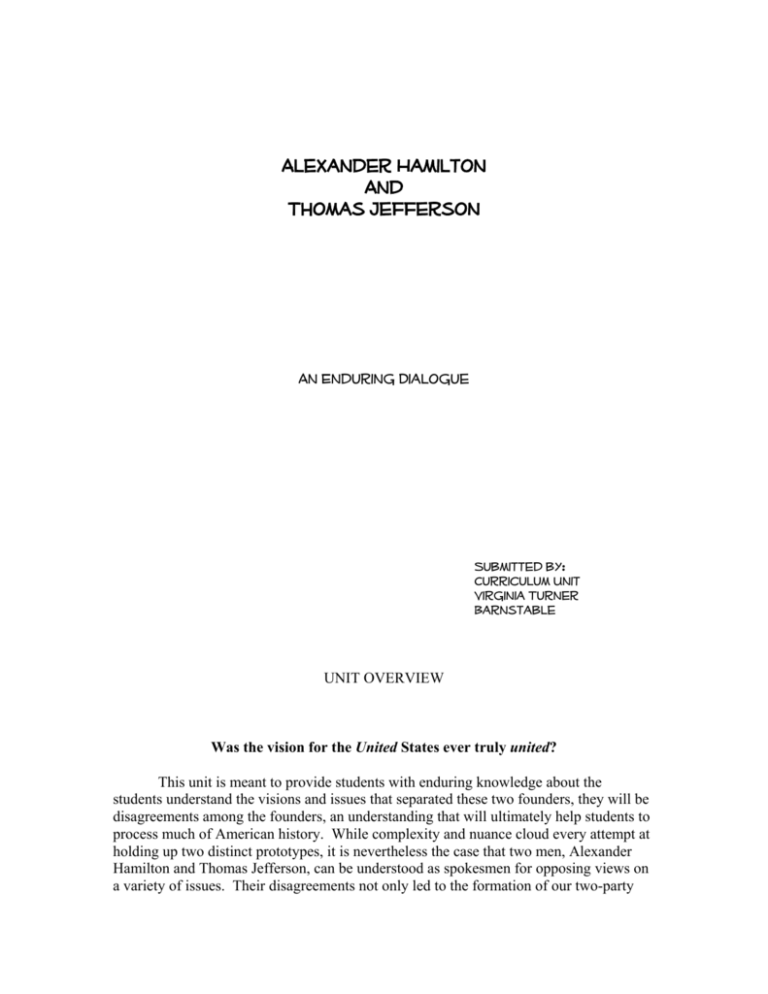
Alexander Hamilton And Thomas Jefferson An Enduring Dialogue Submitted by: Curriculum Unit Virginia Turner Barnstable UNIT OVERVIEW Was the vision for the United States ever truly united? This unit is meant to provide students with enduring knowledge about the students understand the visions and issues that separated these two founders, they will be disagreements among the founders, an understanding that will ultimately help students to process much of American history. While complexity and nuance cloud every attempt at holding up two distinct prototypes, it is nevertheless the case that two men, Alexander Hamilton and Thomas Jefferson, can be understood as spokesmen for opposing views on a variety of issues. Their disagreements not only led to the formation of our two-party system at the turn of the last century, but also have great resonance today in our debates about the proper role of the national government in our lives. The hope is that once able to apply the respective worldviews to various junctures in American history. Questions for discussion could be posed throughout the year, such as: “Was Theodore Roosevelt more Hamiltonian or Jeffersonian in his approach toward trusts?” “What elements of each view helped to form the New Deal?” “Was the Reagan Revolution Hamilton and Jefferson. Application at this point is limited to the contemporary scene, purely Hamiltonian?” Necessarily, this unit attempts to clearly differentiate between but application is also anticipated in succeeding units of any survey course on U.S. history. In order to frame the learning and to lay the groundwork for enduring knowledge, essential questions must be explicit and primary. Certain broad questions provide an overview of the unit (Has the vision of the U.S. ever truly been united? How does the Constitution allow for an enduring philosophical debate about the character of the American system? ), while sub-questions are more directed to the content of the learning emerged from the Constitutional Convention? What roles do political parties perform? (What competing understandings of the “true principles of Republican Government” the unit investigates the “human element,” in asking a purely speculative question: How Why did political parties coalesce around Hamilton and Jefferson?). In addition, part of does a person’s early life affect their later political views? In framing the learning in this way, the goal is twofold: to refrain from presenting our early history as a mere progression of events with foregone conclusions, and to connect the learning about the founding to the students’ very modern lives. The Unit consists of (at least) 10 days, and requires the students to undertake a variety of performance tasks and learning activities. The use of a textbook is assumed, and supplemental readings are suggested for each lesson. The culminating activity contemporary political dialogue, utilizing the analytical tools developed through their revolves back to the overarching essential question, asking students to deconstruct the study of Hamilton and Jefferson. 1. Content standards: USI.2: Explain the historical and intellectual influences on the American Revolution and the form and framework of the American government. USI.8: Describe the debate over ratification of the Constitution between the Federalists and the Anti Federalists and explain the key ideas contained in the Federalist Papers. USI.22: Summarize the major policies and political developments that took place during the presidency of George Washington, John Adams and Thomas Jefferson: a. Origins of the Federalist and Democratic-Republican parties in the 1790s. b. c. d. Conflicting ideas of Thomas Jefferson and Alexander Hamilton. Alien and Sedition Acts. Louisiana Purchase. 2. Key ideas, major themes, big concepts and essential understandings embedded in or which transcend the standards listed above? Essential questions: Has the vision for the United States ever been united? How does the Constitution allow for an enduring philosophical debate about the character of the American political system? How does a person’s early life affect their political views? Sub-questions: What competing understandings of the “true principles of Republican Government” emerged from the Constitutional Convention? What roles do political parties perform in a political system? Why did political parties coalesce around the beliefs of Alexander Hamilton and Thomas Jefferson? How did the beliefs of Hamilton and Jefferson translate into policies during the early republic? How does the human element affect political developments? What were the key life experiences of Hamilton and Jefferson that help us understand their divergent views? Why is this philosophical debate enduring? Can we see elements of this debate in today’s polity? 3. Students demonstrate understanding: Students will: • Understand the fundamental differences between the views of the Federalists and Antifederalists. • Analyze how the views of Hamilton and Jefferson translated into policies. • Analyze the differences between the views of Hamilton and Jefferson and understand how those differences allowed for competing views of the American republic, developing the first party system. • Analyze how the views of Jefferson and his policies at times conflicted and speculate on the reasons. • Understand how political views are partially shaped by early experiences through an examination of Hamilton and Jefferson. Apply the knowledge gained as a lens to aid in understanding contemporary political debates. Students will demonstrate these skills and knowledge through: • Discussion and participation in Socratic seminars • Editorials • Graphic organizers • Role play/debates • Political cartoons • Role play/impeachment trial • Perspective writings • Analytical essays • 4. Tasks/products to demonstrate student understanding: a. Editorial in support of Federalist or Antifederalist view during the ratification debate. (Begins to answer essential question: How does the Constitution allow for an enduring political debate?) 1. After reading and class discussion, students will be assigned to take the Federalist or Antifederalist position on ratification. 2. Students will write an editorial in support of their position, using at least three quotes from the framers (found in the assigned readings) to support their opinion. Students will choose the state within which to publish the editorial, composing the editorial in the context of that particular ratification debate. 3. Students will develop a clear position that is evident in a strong thesis that recognizes the complexity of the issue. 4. Students will support the thesis with historically accurate information. 5. Students will include a conclusion that revisits the thesis, summarizes the main points, and creates a sense of closure. 6. Students will proofread to ensure that the editorial is in publishable form: no grammatical, spelling or punctuation errors. b. Graphic organizer that captures the commonalities and differences in the views of Hamilton and Jefferson as they develop during Washington’s administration. (Begins to answer essential question: Why did political parties coalesce around the opposing beliefs of Hamilton and Jefferson?) c. The Great Debate: Hamilton and Jefferson on the issues. (Addresses essential question: How did the political beliefs of Hamilton and Jefferson translate into policies? and attempts to avoid presentism) See Appendix 1 for rubric. The class will be divided into two teams. One half of the class will “be” Hamilton and the other half will “be” Jefferson. Each team will nominate a speaker. The following issues will be debated: • Funding of the Debts • Bank of the United States Whiskey Excise Tax • Protective Tariff • French Revolution. Each team will be allowed 2-3 minutes to respond to each issue, stating their position and setting forth clear reasons. Each team will be allowed a 1-2 minute response. At the conclusion, teams will be allowed a question and answer session as a means to clarify any confusion. • d. Political cartoons that capture the essence of the debate. Students will create cartoons that have a clear point of view on one or more of the issues of the debate, and that relay a strong message regarding the opposing view. The cartoons must contain some symbolism and must contain detail that evidences the student’s appreciation for the complexity of the issue(s). The Cartoons will be submitted with a 1-2 page paper that answers the question: If you had lived in the late 1790s, which party would you have favored and why? e. Essay: The following essay, from the AP curriculum, will be assigned: Although the power of the national government increased during the early republic, this development often faced serious opposition. Compare the motives and effectiveness of those opposed to the growing power of the national government in TWO of the following: Whiskey Rebellion, Creation of the National Bank, VA and KY Resolutions, Alien and Sedition Acts. See Appendix 2 for rubric. f. The Impeachment of Thomas Jefferson. (This addresses the essential question: How did beliefs translate into policies?) Students will role-play an impeachment of the president based upon the following (not really impeachable) charges: • Violation of the Constitution • Destruction of the separation of powers by illegally expanding the powers of the Executive • Undermining the US economy • Destroying the government service through the use of patronage Students will elect one student to represent Jefferson, and the rest will be divided into prosecution and defense teams. Students will demonstrate an appreciation for the complexity of the issues of Jefferson’s presidency as well as for the contradiction between Jefferson’s previous views and his presidential initiatives. At the conclusion of the trial, students will vote on whether or not to impeach the President. See Appendix 3for rubric. g. Scrapbooks and Tabloid pages. To bring the “human element” into the students’ understanding of this era, students will be asked to create the following: (Begins to shed light on the question: How does a person’s experiences affect their political views?) • Students will create a scrapbook for Hamilton or Jefferson chronicling the key moments of his life. This will be is a personal and intimate snapshot. The • h. scrapbook must contain 6 items that “tell the life story” of Hamilton or Jefferson. Scrapbooks, unlike diaries, do not afford us the opportunity to describe events in words. Hence, you will write a 1-2 page paper that will serve as a key to the scrapbook, providing a rationale for including each item. The tabloid. Students will compose a tabloid page for both Hamilton and Jefferson. These pages will demonstrate an understanding of the social and political climate and will demonstrate an understanding of the events that marred the character of each of these men. (This idea is borrowed from http://faculty.gvsau.edu/hofffmann.) Culminating essay: How does the Constitution allow for an enduring political debate? In what ways are the early visions of Hamilton and Jefferson reflected in contemporary politics? Are we more Hamiltonian or Jeffersonian? Students will develop a 3-5 page response to this question, choosing at least three areas where the debate between Hamilton and Jefferson finds expression today. See Appendix 2 for rubric. 5. Task analysis regarding the skills, the knowledge and the level of understanding: Skills Research skills Analysis Compare and Contrast Debating skills Technology skills Oratory skills Presentation skills Writing skills Thesis creation and defense Knowledge Shays’ Rebellion Ratification Debate Federalists and Antifederalists Federalist Papers Bill of Rights Federalism Administrations of Washington, Adams and Jefferson Hamilton’s financial program Judiciary Act of 1789 Tariff Act of 1789 Federalists and Democratic-Republicans French Revolution Loose and strict interpretation Whiskey Rebellion Treaty of Greenville Jay’s Treaty Pickney’s Treaty XYZ Affair Alien and Sedition Acts States rights VA and KY Resolutions Revolution of 1800 Marbury v. Madison Louisiana Purchase Embargo Act Nonintercourse Act National Debt Tariffs The duel Sally Hemings Hamilton’s chick 6. Preassessment/framing of the learning: a. Preview the essential questions of this unit with the class, explaining how students will begin to think about each of the sub-unit questions. We will brainstorm together regarding answers to these questions. Using one of the issues in the current presidential election, guide the students in viewing the issues from different perspectives, namely, in terms of the role of government and of interest groups. b. Students will receive a handout that clearly states the objectives of the unit, the essential questions and the standards addressed. There will be a holistic scoring method for the unit so that students understand what will be expected. The scoring will be as follows: Editorial, 25 points; Graphic Organizer, 20 points; Debate performance, 25 points; Cartoon and paper, 25 points; Essay on power of the national government, 50 points; Impeachment, 25 points; Scrapbook and paper, 25 points; tabloid, 15 points; Final essay, 100 points; Participation in class discussions, 20 points. Total: 330 points. c. To aid in understanding the standards and expectations, exemplars of past student performance should be provided. d. Students will be pre-assessed on their knowledge of the Constitution and the distribution of power within the national government and between the states and the national government. 7. Methods of presentation and active learning experiences: Day One and Two: A. Objectives: 1. Contrast Federalist and Antifederalist arguments over ratification of the Constitution. 2. Analyze the strategies of the two sides to the debate. 3. Compare and contrast the visions for the future put forth by the founders. B. Supplemental Readings: Federalist Papers Nos. 10, 51; Letter from James Madison to Thomas Jefferson, dated October 24, 1787, and letter from Thomas Jefferson to James Madison, dated December 20, 1787, in Michael Kammen, ed., The Origins of the American Constitution, 1986; “The Battle for Ratification”, pp. 169-190, in Carol Berkin, A Brilliant Solution, 2002. C. Lesson activities: 1. Preassessment on the form of government established by the Constitution. Have students recall what they have previously learned about the structure of the government and the reasons for the terms of the articles. Clear up any misconceptions. 2. Constuct a T-chart with the students regarding the differences between the Federalist and Anti-federalist views. 3. Ask students to describe, from their readings, the strategies of the two groups in the ratification debate. 4. Review with the students the significance of Federalist No. 10, ensuring that students understand Madison’s fear of factions and his argument regarding taming the affects of factions. 5. Summarizer: In the last five minutes, ask students to perform a 3-2-1 summation of the lesson, listing three prominent individuals at the convention and in the ratification debate, 2 main areas of disagreement, and 1 important compromise that allowed for ratification. D. Assignment: Editorial. (See 4a. above.) Day Three, Four and Five: A. Objectives: 1. Students will understand how the U.S. confronted the difficult task of forming a new government. 2. Students will analyze the differences between the political ideas of Hamilton and Jefferson. 3. Students will describe how these political differences evolved into a two-party system, recognizing the significance of the “Revolution of 1800.” 4. Identify the deep divisions between the Federalists and Republicans, e.g. the XYZ Affair, the Alien and Sedition Acts, and the VA and KY Resolutions. B. Supplemental Readings: “The Hamilton Vision,” pp. 78-114 and “The Jeffersonian Vision,” pp. 280-309, in Darren Staloff, Hamilton, Adams, Jefferson, The Politics of Enlightenment and the American Founding, 2005; “Alexander Hamilton, The Founding Wizard,” John S. Gordon, Historical Viewpoints, Vol. One, 9th ed., 2003; Alexander Hamilton, First Report on the Public Credit; Thomas Jefferson, “The Hamiltonian System,” H. A. Washington, IX, pp. 87-99; Washington’s Farewell Address and Jefferson’s First Inaugural Address. C. Lesson activities: 1. Brainstorming: What were the political and economic problems facing the nation with ratification? Ask students to get up and add to big sheets of paper, one entitled “Political Problems,” and one “Economic Problems.” 2. View and discuss PowerPoint Slide on “The Virtuous Republic.” Appendix 4. 3. Remind students that the founders could not see into the future. Discuss possible solutions to the problems listed. 4. View PowerPoint slide on “Origins of the Two Party System,” at www.fhs.d211.org/departments/socialstudies/kpalmer. 5. Ask students to take notes as they view segments of PBS series on Hamilton’s program. 6. Ask students to take notes as they view Powerpoint on Jefferson as President, www.powayusd.com/teachers/clewis/APUSH%20C1113/Jefferson.ppt#256,1,Age of Jefferson. (Economic program, Political program, Foreign Policy of isolation, Louisiana Purchase, Marbury v. Madison) 7. Ask students to work in pairs to create graphic organizers that capture the different positions of Hamilton and Jefferson as well as the justifications for their positions on the following topics: Funding and assumption of debts, the Bank of the United States, the Whiskey Excise tax, the protective tariff, the French Revolution, the VA and KY Resolutions, and the Alien and Sedition Acts. (See 4b above.) 8. Divide the class into two teams, one team to represent Hamilton and one team to represent Jefferson. Conduct a debate around the issues on the graphic organizer. (See 4c above.) 9. Working in groups, ask students to create thesis statements for the question: Although the power of the national government increased during the early republic, this development often faced serious opposition. Compare the motives and effectiveness of those opposed to the growing power of the national government in TWO of the following: Whiskey Rebellion, Creation of the National Bank, VA and KY Resolutions, and the Alien and Sedition Acts. Post theses and discuss. D. Assignments: Political cartoon, see 4d above. Compose essay, see 4e above. Day Seven and Eight: A. Objectives 1. Students will analyze the policies of the second Jeffersonian administration in light of his philosophy. 2. Students will understand the consequences of policies such as the Impeachment of Justice Chase, and the Embargo and Non-Intercourse Acts. B. Supplemental Readings: “We are all republicans, we are all federalists” and “A Splendid Misery,” pp. 135-158, in R. B. Bernstein, Thomas Jefferson, 2003. C. Lesson activities. 1. Discuss with students the major issues of Jefferson’s presidency. 2. Break class into two groups to prepare and role-play an impeachment trial on the following issues: violation of the constitution, destruction of the separation of powers, undermining the US economy and destroying government service. (See 4f above.) Day Nine: A. Objectives: 1. Students will understand and contrast the early lives of both Hamilton and Jefferson. 2. Students will understand the scandals that marked both men’s lives and appreciate each scandals’ effects. B. Supplemental Readings: “Introduction” and “A Young Gentleman of Virginia,” pp. ix-14, in R. B. Bernstein’s Thomas Jefferson, 2003; http://www.pbs.org/wgbh/amex/adams/peopleevents/p_jefferson.html; pages in Chernow’s Alexander Hamilton on Hamilton’s childhood; http://www.pbs.org/wgbh/amex/hamilton/peopleevents/p_a_hamilton.html. C. Lesson activities. 1. Put students in groups of four. Ask students to develop a comparative chart of the events in the young lives of Hamilton and Jefferson. When complete, ask students if they can draw any lines of causation from the early experiences to the later views. Discuss the validity of this approach. 2. Discuss the scandals attendant to each statesman’s life. Can we draw parallels today? What were the effects of these scandals? 3. Ask students to choose either Jefferson or Hamilton. Each student will be asked to create a Scrapbook and a Tabloid piece based upon their readings and our discussion. (See 4g above.) D. Day Ten: Assignment: Culminating essay: How does the Constitution allow for an enduring political debate? In what ways are the early visions of Hamilton and Jefferson reflected in contemporary politics? Are we more Hamiltonian or Jeffersonian? In what ways? (See 4h above.) Unit exam. Extra credit assignment: Create a National Monument to Alexander Hamilton, accompanied by a 1-2 page paper explaining three features of the monument and their connection to Hamilton’s life work.
